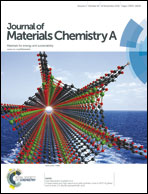A high voltage solar cell using a donor–acceptor conjugated polymer based on pyrrolo[3,4-f]-2,1,3-benzothiadiazole-5,7-dione†
Abstract
We report an improved synthesis of the electron-accepting unit pyrrolo[3,4-f]-2,1,3-benzothiadiazole-5,7-dione (BTI) and the synthesis and characterisation of two donor–acceptor copolymers containing it: poly[6-dodecyl-4,8-bis(2-thienyl)pyrrolo[3,4-f]-2,1,3-benzothiadiazole-5,7-dione-alt-9,9-dioctyl-2,7-bis(thien-2′-yl)-9H-fluorene] (P(BTI-F)), and poly[6-dodecyl-4,8-bis(thien-2′-yl)pyrrolo[3,4-f]-2,1,3-benzothiadiazole-5,7-dione-alt-4,8-bis(octyloxy)benzo[1,2-b:4,5-b′]dithiophene] (P(BTI-B)). By the incorporation of an imide group onto a benzothiadiazole moiety, the HOMO level is lowered. To explore the effectiveness of conjugation along the polymer backbone, two electron donors: fluorene and benzobithiophene, were introduced. These represent a weak and a strong electron-donor, respectively. Both polymers have low lying HOMOs and hence are thermally stable and also result in high open-circuit voltages (Voc) in photovoltaic applications. Compared to P(BTI-B), P(BTI-F) has a larger bandgap due to the incorporation of a weaker donor unit and thus a deeper lying HOMO level. Devices based on P(BTI-F) and [6,6]-phenyl-C61-butyric acid methyl ester (PC61BM) can obtain a remarkably high Voc of 1.11 V, but a PCE of only 1.61%. By contrast, polymer P(BTI-B) has stronger absorption in the longer wavelength range and can achieve a well-dispersed nanomorphology with PC61BM for efficient exciton dissociation, achieving PCE of 3.42%, with a Jsc of 9.71 mA cm−2, Voc of 0.75, and FF of 0.47.
![Graphical abstract: A high voltage solar cell using a donor–acceptor conjugated polymer based on pyrrolo[3,4-f]-2,1,3-benzothiadiazole-5,7-dione](/en/Image/Get?imageInfo.ImageType=GA&imageInfo.ImageIdentifier.ManuscriptID=C4TA01248H&imageInfo.ImageIdentifier.Year=2014)

 Please wait while we load your content...
Please wait while we load your content...